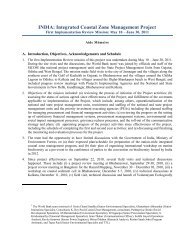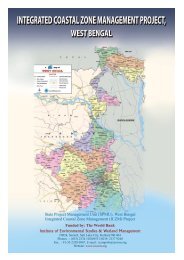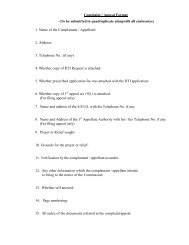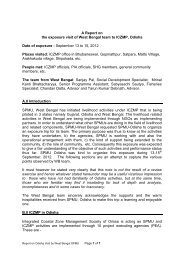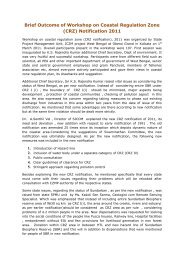Cyclone and Storm Surge - Iczmpwb.org
Cyclone and Storm Surge - Iczmpwb.org
Cyclone and Storm Surge - Iczmpwb.org
Create successful ePaper yourself
Turn your PDF publications into a flip-book with our unique Google optimized e-Paper software.
3.7<br />
3.4 Drainage Scheme of William Clarke<br />
The first major modifications in the drainage system came in the wake of the Sepoy Mutiny, 1857,<br />
when the responsibility of governance changed h<strong>and</strong>s from the East India Company to the Imperial<br />
throne of Engl<strong>and</strong> by the Proclamation of Queen Victoria. Meanwhile, the Calcutta Municipality had<br />
been established earlier in 1841 <strong>and</strong> the scheme for the "Water Carriage System" of the city as<br />
prepared by its first engineer, Mr. William Clarke, was sanctioned on April 20, 1859 <strong>and</strong> cost an<br />
estimated Rs. 34 lakh. The plans under the proposal were executed between 1860 <strong>and</strong> 1875. known<br />
in civic parlance as the "Town System" as separate from the "Suburban System" which came later,<br />
was combined sewerage cum drainage system, designed to drain an average rainfall of 6 mm (1/4<br />
inch) per hour with cent percent run-off in addition to 182 litres (40 gallons) of domestic sewage per<br />
capita per day. The underground drainage system comprised various sized conducts from 6.1 m (20<br />
ft.) dia. brick outfall sewers to 15 cm (6 inches) dia. pipe drains. The main sewers, draining 4600<br />
acres (around 18.50 sq. km.) of l<strong>and</strong> <strong>and</strong> running generally from west to east, were connected on the<br />
summit points to the penstocks opening into the Hooghly river to flush the sewers by the river water.<br />
The bottom points at the east extreme were connected to the intercepting sewer laid along the<br />
Circular Road. The underground drains measured around 2.44m high <strong>and</strong> 1.83m wide, with an eggshaped<br />
cross section. Sewage was lifted at the Palmer's Bridge pumping station to a high level<br />
sewer leading to Tangra <strong>and</strong> finally flowing into the Raja khal, an offshoot of the Bidhyadhari river,<br />
which was a thriving tidal channel at the time. Three storm-water overflows were provided running<br />
into the Circular canal. But the canal authorities resented this undesirable inflow into the canal <strong>and</strong><br />
finally further intercepting sewers were laid under the Canal West Road to intercept all these<br />
overflows <strong>and</strong> to lead them on to the Palmer's Bridge pumping station. Later, in 1896, the scheme<br />
was modified to include an additional drainage area, thus resulting in a total area of 19.2 sq. km.<br />
Most of the drainage network as established under the Clarke’s scheme is still giving service to the<br />
city, though the outfall into the river Bidhyadhari had to be changed later due to its high siltation. This<br />
aspect is discussed in section 2.4.7.<br />
3.5. Drainage scheme of Hughes <strong>and</strong> Kimber<br />
Hemmed in by the Hooghly river on the west <strong>and</strong> the Salt lakes on the east, the city grew largely in<br />
the south in preference to the north, where adequate l<strong>and</strong> was difficult to come by. To meet the<br />
drainage requirement of these freshly built up areas in the south, the Ballyganj pumping station was<br />
proposed. The Palmer's Bridge pumping station also needed augmentation in capacity to dispose a









